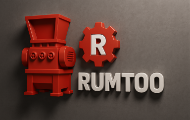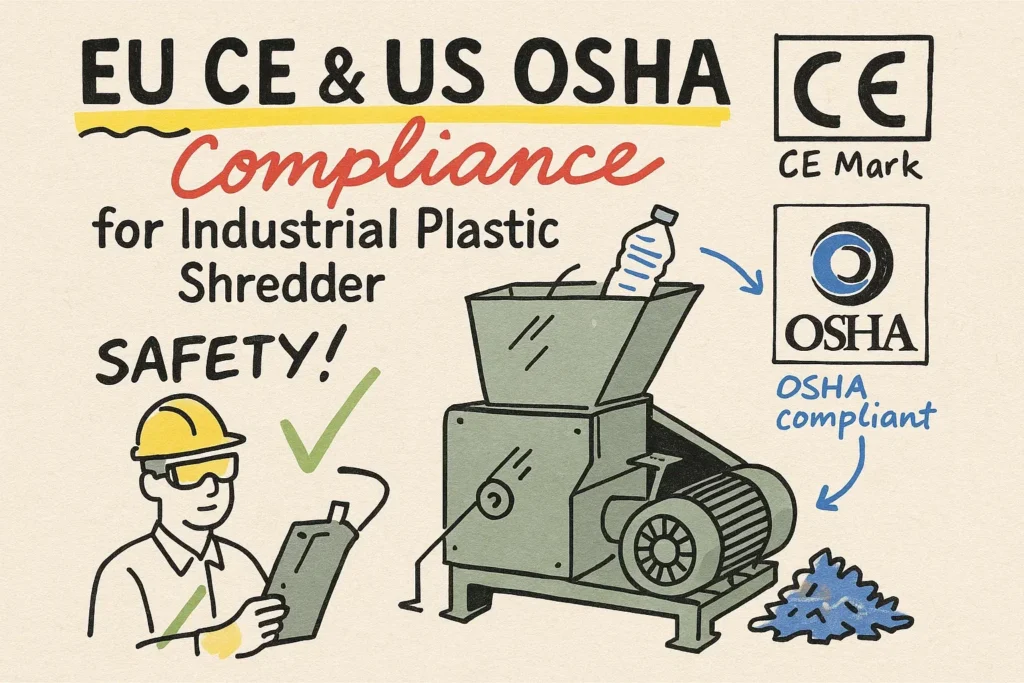Safety First: A Clear Explanation of EU CE & US OSHA Compliance for Industrial Plastic Shredders
Industrial plastic shredders are powerhouses in recycling and waste management, efficiently reducing large volumes of plastic waste to manageable sizes. However, their strength also brings inherent risks. Ensuring the safety of these machines requires navigating complex regulatory landscapes, primarily the EU CE marking requirements and the standards of the U.S. Occupational Safety and Health Administration (OSHA).
For buyers, engineers, and technical staff, understanding these compliance frameworks is not just about ticking boxes; it is fundamental to ensuring worker safety, maintaining operational efficiency, avoiding high fines, and securing market access. This article explains what CE marking and OSHA compliance mean for industrial plastic shredders, and helps you make informed decisions and prioritize safety.
How Industrial Plastic Shredders Work (and What Are the Risks)?
Before delving into the regulations, a brief overview of what these machines do and where the dangers lie. An industrial shredder typically consists of:
- Infeed Chute: Where material is introduced.
- Cutting Chamber: Enclosure of powerful rotating blades or knives mounted on rotors.
- Drive System: Motors and gearboxes that provide torque.
- Discharge System: Where processed material leaves the machine.
- Control Panel: For operation and safety functions.
Common Hazards Include:
- Entanglement/Slicing: Contact with moving blades or rotors.
- Projectiles: Material that is ejected during the shredding process.
- Electrical Shock: From motors, wiring, or control panels.
- Unexpected Startup: During maintenance or clearing jammed material (Lockout/Tagout is crucial here).
- Noise: High operational noise levels.
- Dust: Potential respiratory risks depending on the material.
Explanation of EU CE Marking for Shredders
What is CE Marking?
The CE marking (Conformité Européenne) is a mandatory marking for certain product groups sold within the European Economic Area (EEA) – consisting of EU countries plus Iceland, Liechtenstein, and Norway – and Turkey. By affixing the CE marking, the manufacturer declares that the product meets all applicable EU requirements regarding safety, health, and environmental protection. It is essentially a passport to bring the product to the European market.
Why is it Important?
- Market Access: Legally required to sell shredders in the EEA.
- Safety Guarantee: Indicates that fundamental EU safety standards are met during the design and manufacturing phase.
Important Directives for Shredders:
The most crucial directive is the Machinery Directive (2006/42/EC). This directive describes the Essential Health and Safety Requirements (EHSRs) for machines. Depending on the specific features of the shredder, other directives may also apply, such as:
- Low Voltage Directive (LVD) (2014/35/EU): For electrical safety.
- EMC Directive (Electromagnetic Compatibility) (2014/30/EU): To ensure that the equipment does not cause interference or is affected by other electronic devices.
- ATEX Directive (2014/34/EU): If used in potentially explosive atmospheres.
- Outdoor Noise Emission Directive (2000/14/EC): If intended for outdoor use and certain noise levels are exceeded.
Manufacturer's Responsibility:
The manufacturer (or its authorized representative in the EU) is solely responsible for:
- Conducting a thorough risk assessment.
- Ensuring that the shredder meets all relevant EHSRs from applicable directives.
- Compiling a Technical Dossier %%
- with design drawings, risk assessments, test reports, manuals, etc. %%Preparing and signing an
- %% EC Declaration of Conformity (DoC) %%
- listing the adhered guidelines and standards. %% Applying the visible, legible, and permanent
%%
- CE marking
- %% %%to the shredder.
- %%
Providing a contact point established in the EU
%%
on the product or packaging (mandatory since July 2021). %% What Buyers Should Look Out For: %%The physical presence of the CE marking on the shredder or the type plate. %% Request and check the
Why is it Important?
- %% . Check if it lists the Machinery Directive (2006/42/EC) and possibly other directives.
- %% Check if the DoC is signed and contains the manufacturer's and EU contact point information.
- %% Navigating US OSHA Compliance for the Use of Shredders
%%
What is OSHA Compliance?
- %% OSHA regulations focus on
- %% workplace safety
- %% in the
- %% United States
- %% . Unlike the CE marking (product-oriented), OSHA standards dictate how
- %% employers
%%
- must provide a safe working environment and ensure that equipment is operated and maintained safely. Compliance is mandatory for most private sector employers in the US. %% Worker Protection:
- %% Legally required protection against workplace hazards. %%
- Avoiding Fines: %% OSHA conducts inspections and can impose significant fines for non-compliance.
- %% Cost Reduction: %%
- Prevents accidents, injuries, and associated costs for workers' compensation insurance and operational downtime. %% Important OSHA Standards Applicable to Shredders:
%%
Although OSHA has no standard that is *specifically* for "plastic shredders," various general industry standards are highly relevant and enforceable (within the US):
- %%
- Are there clear, designated points for installing Lockout/Tagout devices?
- Is the noise level documented?
- Does the manual provide clear instructions for safe operation, maintenance, and LOTO?
CE vs. OSHA: Understanding the Difference
It is crucial to understand that CE marking and OSHA compliance are not interchangeable. They address different aspects of safety: | Feature | EU CE Marking | US OSHA Compliance | |---------|---------------|--------------------|
| | Primary Goal | Product safety for market access | Workplace safety during use and maintenance | | | Focus | Machine design & construction | Machine use, maintenance, employee training, environment | | | Responsibility | Manufacturer / EU Authorized Representative | Employer | |
|---|---|---|
| | Geography | European Economic Area (EEA) + Turkey | United States | | | Nature | Manufacturer's self-declaration (often) | Legal requirement for employers, enforced by inspection | | | Result | Product can be legally sold/branded in the EU market | Safe working environment for employees | |
| A CE-marked shredder does not automatically mean that the American employer is fully OSHA-compliant after installation. The employer must still ensure correct installation, location-specific risk assessment, LOTO procedures, training, etc. However, a well-designed, CE-marked machine often contains safety features that facilitate achieving OSHA compliance. | Why Prioritize Compliance? Tangible Benefits | Investing time and resources in ensuring both CE (if applicable) and OSHA compliance yields significant benefits: |
| | Protection of Your People | This is the most important benefit. Fewer accidents mean fewer injuries and fatalities. | | | Protection of Your Outcome | Avoid costly OSHA fines (in the US), possible lawsuits, increased insurance premiums, and productivity loss due to accidents and downtime. | | | Ensuring Market Access | CE marking is essential for selling on the lucrative European market. | |
| | Improvement of Efficiency & Morale | Safe, well-maintained equipment operates more reliably. Employees who feel safe and valued are generally more productive and have higher morale. | | | Improvement of Reputation | A strong safety performance signals quality and responsibility to customers, employees, and the industry. | %% |
| Choosing and Implementing a Compliant Shredder: Action-Oriented Steps | Due Diligence for Buyers & Engineers: | Define Your Market: |
| Are you buying for the EU/EER or the US (or both)? | If Purchase for EU/EER: | Check the CE Marking: |
Ensure it is present on the machine.
Request the EC Declaration of Conformity (DoC):
Check it carefully. Does it mention the correct directives (Machine Directive 2006/42/EC)? Is it signed?
- Request the Technical File: Although you may not receive the entire file, the manufacturer should be able to provide summaries or confirmation of its existence.
- Confirm the EU Contact Point. If Purchase for US:
- Evaluate OSHA-Related Characteristics: Critically evaluate the guarding (fixed, locked?), placement of emergency stops, LOTO provisions, followed electrical safety standards, noise data, and the quality of the operating/maintenance manuals.
- Ask Specific Questions: “How does the guarding of this shredder comply with OSHA 1910.212?” “Show me the designated LOTO points.”
- Pay Attention to Essential Safety Features (Supports both CE and OSHA): Robust physical guards (fixed or locked) that prevent access to the cutting chamber and power transmission parts.
Clearly marked, easily accessible Emergency Stop Buttons (E-stops).
Designated, lockable energy-isolation points (main electrical switch, hydraulic valves, etc.) for LOTO.
- Safety interlocks on access doors/panels that stop the machine when opened. Clear, durable warning labels regarding hazards.
- After Purchase: Employer Responsibilities (Focus on OSHA in the US):
- Controleer de CE-Markering: Zorg dat deze aanwezig is op de machine.
- Vraag om de EG-verklaring van Overeenstemming (EvO): Controleer deze zorgvuldig. Vermeldt deze de juiste richtlijnen (Machinerichtlijn 2006/42/EG)? Is deze ondertekend?
- Vraag naar het Technisch Dossier: Hoewel u misschien niet het volledige dossier krijgt, moet de fabrikant samenvattingen of bevestiging van het bestaan ervan kunnen geven.
- Bevestig het EU-Contactpunt.
- Indien Aankoop voor VS:
- Beoordeel OSHA-Relevante Kenmerken: Evalueer kritisch de afscherming (vast, vergrendeld?), plaatsing van noodstoppen, LOTO-voorzieningen, nageleefde elektrische veiligheidsnormen, geluidsgegevens en de kwaliteit van de bedienings-/onderhoudshandleidingen.
- Stel Specifieke Vragen: “Hoe voldoet de afscherming van deze shredder aan OSHA 1910.212?” “Toon mij de aangewezen LOTO-punten.”
- Let op Essentiële Veiligheidskenmerken (Ondersteunt zowel CE als OSHA):
- Robuuste fysieke afschermingen (vast of vergrendeld) die toegang tot de snijkamer en krachtoverbrengingsdelen voorkomen.
- Duidelijk gemarkeerde, gemakkelijk toegankelijke Noodstopknoppen (E-stops).
- Aangewezen, vergrendelbare energie-isolatiepunten (elektrische hoofdschakelaar, hydraulische kleppen etc.) voor LOTO.
- Veiligheidsvergrendelingen op toegangsdeuren/-panelen die de machine stoppen wanneer ze worden geopend.
- Duidelijke, duurzame waarschuwingslabels met betrekking tot gevaren.
Na Aankoop: Verantwoordelijkheden Werkgever (Focus op OSHA in de VS):
- Conduct a location-specific risk assessment for the installation and use of the shredder.
- Develop, document, and implement machine-specific Legally required protection against workplace hazards..
- safe work procedures Establish safe work procedures.
- Ensure thorough training for operators and maintenance staff on hazards, guarding, safe operation, and LOTO.
- Implement a regular inspection and maintenance program for the shredder and associated safety equipment, and maintain documentation of this.
Conclusion: Safety is Non-Negotiable
Navigating through CE marking and OSHA requirements for industrial plastic shredders may seem complex, but it is an essential part of responsible purchase and operation of equipment. CE marking ensures a basic level of product safety for the EU market, driven by the manufacturer. OSHA compliance ensures continuous workplace safety in the US, driven by the employer.
By understanding these distinct but complementary frameworks, asking the right questions during purchase, and implementing robust safety practices in your facility, you can protect your employees, ensure legal compliance, improve operational efficiency, and protect your company's reputation. Prioritizing safety is not only good practice – it is good business.
Disclaimer: This article provides general informational guidance and does not constitute legal or specific technical advice. Always refer to the full text of relevant EU directives, OSHA standards, and consult qualified safety professionals or legal advisors for your specific situation.


